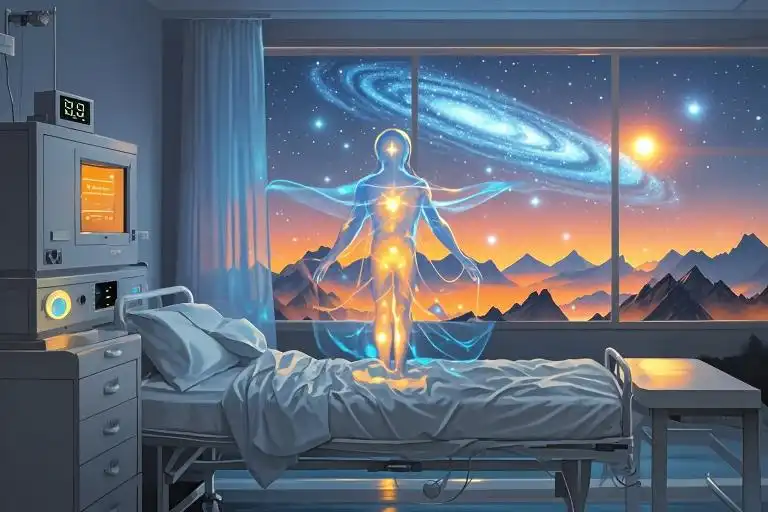The retirement fantasies of a 19-year-old might seem premature, but they reveal something fundamental about our times. While my peers worry about college majors and first jobs, I find myself fixated on that distant moment when work becomes optional – not because I crave idleness, but because I fear never achieving true contentment. Growing up in Southern New Jersey’s labyrinthine suburbs, where identical houses stretch for miles between strip malls and retirement communities, I developed an early allergy to what passes for the American dream. The suffocating sameness of those planned neighborhoods, their cookie-cutter aesthetics and isolation from anything wild or unpredictable, made me dread the conventional path.
What calls to me instead are places like Twin Peaks – not the surreal murder mysteries, but the physical setting itself. Those misty mountains and dense forests represent an existence where life isn’t mediated by shopping centers and monthly car payments. There’s irony in a digital native longing for such analog simplicity, but that tension defines our generation’s struggle. We’ve inherited a world where satisfaction is systematically postponed, where every solved desire immediately births new ones. Consumerism doesn’t just sell products; it sells the permanent state of wanting.
This paradox forms the core of my anxiety: the more options we have, the harder contentment becomes. Modern life offers unprecedented material comfort while making authentic satisfaction nearly impossible. We’re trapped in what some philosophers call the ‘hedonic treadmill’, running faster just to stay in place. My retirement daydreams aren’t about escaping work, but escaping this system that converts every human need into a purchasable solution. The real challenge isn’t financial planning, but learning how to want differently – how to desire in ways that don’t bind us to perpetual consumption. Perhaps that’s why the wilderness calls so strongly; nature doesn’t care what brand your hiking boots are, doesn’t bombard you with upgrade notifications. Its demands are elemental, its rewards uncommodified.
Yet here I sit, typing these thoughts on a smartphone, acutely aware of the contradictions. That cognitive dissonance might be the defining experience of young adulthood today – knowing the system’s flaws while remaining dependent on its conveniences. My generation didn’t create this machine, but we’re the first to grow up with its mechanisms fully visible. We see how social media algorithms manipulate our attention, how planned obsolescence engineers our dissatisfaction, how even leisure becomes monetized. The suburban maze I loathe isn’t just physical; it’s the psychological labyrinth of late capitalism, where every exit seems to lead back to another shopping aisle.
The Modern Curse of Insatiability
The glow of my iPhone screen casts shadows across my bedroom walls as I scroll past another ad for the latest model. It’s thinner, faster, shinier – promising to make me more creative, more connected, more me. Except the me in the advertisement looks nothing like the bleary-eyed version holding the device at 2am. This is the paradox of our age: we’re surrounded by more ways to fulfill desires than any generation in history, yet contentment remains perpetually out of reach.
Advertising doesn’t just sell products anymore – it sells better versions of ourselves we didn’t know we needed. That fitness tracker whispering from my wrist isn’t merely counting steps, it’s tallying my worth as a disciplined individual. The coffee brand I prefer markets itself as ‘for those who create’, implying my morning brew could transform me into the artist I pretend to be on Instagram. We’ve moved beyond simple consumption into what sociologists call identity economics, where every purchase becomes a brick in the fragile architecture of our self-concept.
Social media platforms perfected this alchemy of turning validation into currency. Those heart-shaped icons beneath our posts aren’t just notifications – they’re tiny doses of dopamine wrapped in the illusion of social acceptance. I catch myself checking like counts the way previous generations might have checked their watches, a nervous tic disguised as habit. The unspoken equation is simple: more likes equals more worth. We’ve outsourced our self-esteem to algorithms designed to keep us craving.
The numbers paint a disturbing picture. Research suggests the average American encounters between 4,000 to 10,000 advertisements daily – from billboards to sponsored posts to product placements in shows. That’s roughly one marketing message every 6 seconds during waking hours. Our brains have become battlegrounds where corporations fight for neural real estate, implanting desires we mistake for our own.
What makes this system particularly insidious is how seamlessly it maps onto human psychology. Evolutionary biologists suggest our brains are wired to constantly compare ourselves to others – a useful trait when survival depended on social cohesion, but disastrous in an era where we can measure ourselves against curated highlight reels of millions. The fitness influencer’s ‘perfect’ morning routine, the entrepreneur’s ‘hustle porn’, the travel blogger’s endless vacation – these aren’t just images, they’re psychological bait.
I notice this most in small moments of dissonance. That pang when a friend’s promotion appears on LinkedIn while I’m watching Netflix. The inexplicable urge to buy organic kale after seeing a celebrity’s fridge tour. The quiet shame of ordering takeout while food bloggers preach meal prep. Each microtransaction of envy chips away at whatever fragile contentment I’ve managed to build.
The cruel irony is that the more we consume, the less satisfied we become. Studies on the hedonic treadmill show our happiness baselines adjust rapidly to new possessions – that thrill of a new phone lasts about as long as the factory smell. So we run faster, buy more, upgrade sooner, trapped in what one researcher called ‘the cycle of aspirational despair’. Our ancestors worried about scarcity; we suffer the peculiar misery of abundance without fulfillment.
Perhaps the most telling symptom is how we’ve commercialized resistance to commercialization. Meditation apps with premium subscriptions. Sustainable fashion brands charging triple fast fashion prices. Productivity gurus selling courses on how to avoid distraction. Even our attempts to opt out become monetized, creating Russian nesting dolls of consumption where the antidote comes packaged with its own side effects.
This isn’t accidental – it’s by design. Behavioral economists have shown that predictable irrationality can be engineered. The same psychological triggers that make slot machines addictive – variable rewards, near misses, the endowment effect – power everything from social media feeds to loyalty programs. We’re not choosing to be dissatisfied; we’re being systematically trained to remain perpetually wanting.
The tragedy isn’t that we desire things, but that we’ve lost the ability to distinguish between manufactured wants and authentic needs. Somewhere between the 47th YouTube unboxing video and the targeted ad that follows me across websites, my sense of self got tangled up with things I never consciously chose to value. And that’s the real curse of modernity – not that we can’t have everything we want, but that we no longer know which wants are truly ours.
Who’s Pulling the Strings of Your Desire?
The moment you swipe right on a dating app or refresh your Instagram feed, you’re participating in something far more complex than simple choice-making. It’s as if invisible marionette strings tug at your wrists, guiding you toward desires that might not even be yours to begin with. This unsettling realization first struck me while watching an old episode of Black Mirror – the one where people rate each other with star systems that determine social privilege. That dystopia feels uncomfortably familiar when you notice how many life decisions we make based on projected approval ratings.
French psychoanalyst Jacques Lacan had a term for this phenomenon: the desire of the Other. Not desire for others, but the fundamental truth that our wants are shaped by external systems – the cultural symbols, language structures, and power dynamics surrounding us. Imagine walking through a supermarket aisle where every product whispers You need this to be loved. The iPhone promising connection, the skincare jar guaranteeing admiration, the sneakers assuring belonging. These aren’t just objects; they’re physical manifestations of the symbolic order Lacan described, a web of meanings we’re born into but rarely question.
What makes this especially insidious is how seamlessly these external desires become internalized. Consider two versions of yourself: one scrolling through aspirational Pinterest boards, another lying awake at night wondering why your life doesn’t match those curated images. Both are authentic in their own way, yet both are shaped by forces beyond your control. This isn’t about weakness – it’s about how human identity forms through reflection. Like toddlers recognizing themselves in mirrors for the first time, we constantly adjust ourselves based on the reflections bouncing back from society’s distorted funhouse mirrors.
The advertising industry didn’t invent this vulnerability, but it perfected its exploitation. Their playbook reads like a Lacanian textbook: first create lack (Your lips aren’t plump enough), then position products as bridges to the Ideal Self (This gloss makes you desirable). The genius lies in ensuring the bridge never actually reaches its destination. Buy the gloss, and tomorrow’s campaign will highlight your inadequate eyelashes. It’s a treadmill disguised as a staircase, keeping us running toward horizons that perpetually recede.
This explains why authenticity feels so elusive in consumer culture. When Jean-Paul Sartre wrote about the waiter who plays at being a waiter, he touched on something profound – our identities are performances shaped by audience expectations. The barista crafting latte art for Instagram isn’t just making coffee; they’re enacting a role scripted by social media’s reward systems. There’s no ‘true self’ behind the performance, only different versions responding to different stages and spectators.
But here’s the twist Lacan might appreciate: recognizing this puppet show doesn’t automatically free us from its strings. I can intellectually understand how my wish for a minimalist cabin in the woods stems partly from reactionary Instagram aesthetics, yet the longing persists. That’s the paradox of desire – even when we see the machinery, its effects don’t dissolve. Like knowing a magician’s trick yet still gasping at the illusion.
What remains is not some pure, pre-social essence of self, but something more practical: the ability to choose which strings we’ll dance to. Not total freedom from influence (an impossible fantasy), but conscious selection of which influences deserve our allegiance. This shifts the question from How do I find my true desires? to Which desire-shaping systems align with my values? The difference sounds subtle but changes everything – like realizing you can’t stop the ocean’s currents, but you can decide which ones will carry your boat.
Choosing Your Battleground
The suburban maze I grew up in wasn’t just a geographical quirk—it was a metaphor for how desire works under capitalism. Every identical house, every strip mall selling the same mass-produced goods, felt like another turn in a labyrinth designed to keep me chasing something just out of reach. But labyrinths have exits. The question is whether we’re willing to stop following the pre-marked paths.
The Group Selection Method
Jacques Lacan was right about one thing: we’re always performing for an audience. The twist is that we get to curate that audience. Authenticity isn’t about rejecting all social mirrors—it’s about choosing which reflections matter. Here’s how:
- Audit your influences
Make a list of the five people/communities whose approval you unconsciously seek. Now ask: Do their values align with your unhurried, Twin Peaks retirement fantasy? If your Instagram feed glorifies #VanLife but your closest friends mock minimalism, you’re trying to breathe in two atmospheres at once. - Seek friction
Join one group that actively challenges your default desires. When I started attending a plant-swap group (where people trade cuttings instead of buying new houseplants), I realized how conditioned I was to equate ‘new’ with ‘better.’ Their laughter at my pristine nursery pots was the kind of discomfort that rewires desire. - Build recognition rituals
Capitalism hijacks our need for belonging—so reclaim it. My friend Mark hosts a monthly ‘Unboxing Party’ where people share objects they’ve owned for 10+ years and the stories behind them. It’s anti-haul culture, and it works because it satisfies the same social needs that shopping sprees do, just differently.
The Practical Toolkit
These aren’t grand gestures, just daily resistance tactics:
- Digital Shabbat
Every Saturday, I use a dumbphone from 2007. Not to ‘detox,’ but to remember that FOMO is a myth—the world continues just fine without my scrolling. The first hour feels like withdrawal; by hour three, I’m noticing how birds actually sound. - Secondhand first
Challenge yourself: For every new item, acquire two used ones. It’s not about deprivation—it’s about discovering the pleasure of slow curation. My favorite jacket used to belong to a jazz pianist; his old concert ticket stub was still in the pocket. That’s a story no fast-fashion hoodie can deliver. - Localize your dopamine
Swap Amazon Prime for the ‘20-minute rule’: Any purchase under $50 must come from within a 20-minute walk. You’ll buy less, but each purchase becomes a neighborhood expedition. The Korean market near me sells single pencils wrapped in hanji paper—a far cry from bulk Office Depot packs.
The #MyAuthenticChoice Paradox
When I posted about ditching Spotify for local record stores, the comments surprised me. Half called it ‘privileged’ (fair), but the other half shared their own small rebellions:
- A barista who only uses handmade mugs at home
- A programmer who replaced Slack with handwritten notes for intra-office communication
- A mother tracking her ‘invisible labor’ in a beautiful leather-bound journal instead of productivity apps
None claimed purity. The barista still needs her iPhone; the programmer can’t quit his job. But these choices create pockets of autonomy—like installing airlocks against the vacuum of consumerism.
Here’s the uncomfortable truth: total escape is impossible. Even the Buddhist monks I romanticize rely on donated rice bowls. But the goal was never purity. It’s about learning to distinguish between the desires that bloom from your core and those implanted by the endless suburban maze.
So tonight, I’ll still post this essay online. Tomorrow, I might buy overpriced artisanal coffee. But somewhere between those compromises, there’s a third path—not rejecting the system entirely, but carving out spaces where the carrots dangling before me are ones I actually want to chase.
The Dilemma of the Awakened Mind
There’s an uncomfortable truth those of us critiquing consumerism must confront: the systems we criticize are often the same ones we can’t imagine living without. I type these words on a MacBook while my iPhone buzzes with food delivery notifications—the irony isn’t lost on me. Capitalism’s conveniences have become like oxygen: invisible until you try holding your breath.
The frictionless ease of two-day shipping, streaming services that anticipate our moods, apps that deliver hot meals to our doors—these aren’t just products but psychological infrastructure. They’ve rewired our expectations of how life should function. When my grandfather complains about ‘kids these days’ being unable to wait, he’s not wrong, but he’s missing the larger design. Impatience isn’t our failing; it’s the system working as intended. The same dopamine loops that make social media addictive power our reliance on instant gratification commerce.
Yet the costs accumulate quietly beneath the surface of convenience. Recent CDC data shows depression rates among young adults have nearly doubled in the past decade, with economists drawing direct correlations to ‘competitive consumption’—the arms race of visible lifestyle markers. The Wall-E metaphor feels less like satire and more like documentary: humans floating on mobility scooters, screens permanently fixed before their eyes, everything from food to companionship available at the press of a button. We’ve achieved the dystopia Pixar warned us about, except our hoverchairs have Apple logos.
What makes this particularly insidious is how our critique gets co-opted. Mindfulness becomes a premium meditation app subscription, anti-consumerism a carefully curated aesthetic sold on Etsy. Even my desire to escape to the woods isn’t immune—REI sells $400 hiking boots promising ‘authentic connection with nature.’ The system digest dissent like a stomach acid breaking down food, absorbing what nutrients it can and excreting the rest as marketing materials.
I find myself caught in this tension daily. I’ll spend hours reading Marxist theory, then order dinner through Uber Eats because I’m ‘too tired’ to cook. My bookshelf holds volumes critiquing late capitalism, yet I panic when my phone battery dips below 20%. This isn’t hypocrisy so much as learned helplessness—the psychological state where subjects stop trying to escape negative stimuli because past attempts have failed. Our collective learned helplessness manifests as memes about ‘adulting’ and ironic embraces of behaviors we know harm us.
Perhaps the most honest response isn’t radical rejection but conscious negotiation. Instead of fantasizing about unplugging entirely (a privilege few can afford), we might practice what anthropologist Anna Tsing calls ‘living in the ruins.’ This means making deliberate choices within the system: choosing the local bookstore over Amazon when possible, repairing instead of replacing, treating convenience as occasional tool rather than default setting. It won’t save the world, but it might preserve our sanity.
The Buddhist concept of the ‘hungry ghost’—a being with an insatiable appetite and needle-thin throat—feels increasingly apt. We’re all haunted by versions of ourselves that can never be satisfied, not because we’re flawed but because we’ve been trained to confuse hunger with purpose. My retirement anxiety crystallizes this: I fear reaching life’s later stages only to discover I’ve been chasing the wrong things all along, my desires never truly my own.
So I’ll keep writing on this expensive laptop, but maybe tomorrow I’ll take a walk without my phone. Small resistances accumulate. The maze of consumerism has no center to reach, only walls to notice—and occasionally, push against.
The Paradox of Writing About Authenticity on an iPhone
There’s something deeply ironic about typing these words on a device that represents everything I claim to resist. The glow of the screen illuminates my face as my thumbs dance across glass, each tap a tiny surrender to the very system I’m attempting to critique. This contradiction isn’t lost on me – perhaps it shouldn’t be lost on you either.
Retirement still lingers in my imagination, that distant promise of quiet contentment among real trees rather than suburban clones. Yet here I am, decades away from that hypothetical freedom, already practicing small acts of rebellion that feel both insignificant and necessary. The “weekly resistance” I’ve settled on isn’t dramatic – just one hour every Sunday where my phone stays in airplane mode while I sketch terrible drawings of the pine trees outside my window. They’ll never be as majestic as Twin Peaks’ evergreens, but their crooked branches remind me that perfection was never the point.
What surprises me most isn’t how difficult these small resistances feel, but how capitalism has already co-opted even this modest attempt at authenticity. My sketchbook bears the logo of a major stationery brand; the pencils were a birthday gift from Amazon. The awareness of these contradictions used to paralyze me – why bother resisting if I can’t escape the system completely? But Lacan’s theories offer unexpected comfort here: if all desire is mediated through the Other anyway, perhaps the most authentic choice isn’t rejecting all external influences, but consciously selecting which influences get to shape me.
So I’ll keep writing about consumerism on this iPhone, keep dreaming of retirement at nineteen, keep drawing trees with corporate pencils. The fantasy of pure authenticity may be just that – a fantasy – but in the space between total surrender and impossible purity, there’s room to breathe. Maybe that’s enough for now.
When you look at your own desires today, how many feel like genuine choices versus inherited scripts? I won’t pretend to have answers, only the observation that asking the question at all might be the first real act of resistance most of us ever attempt.





